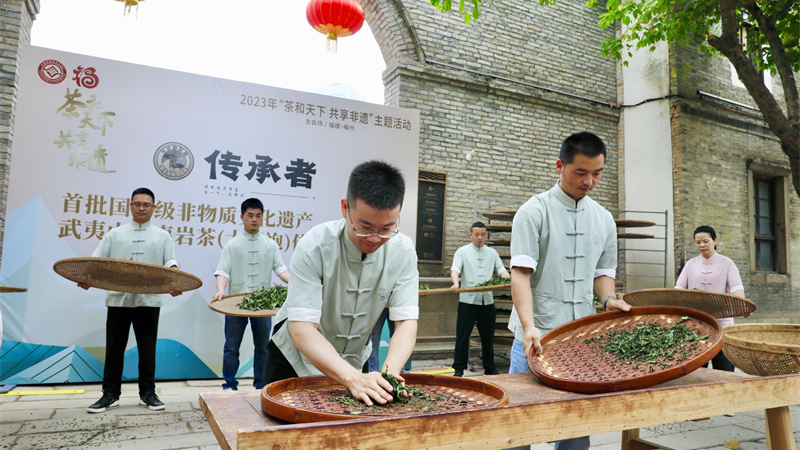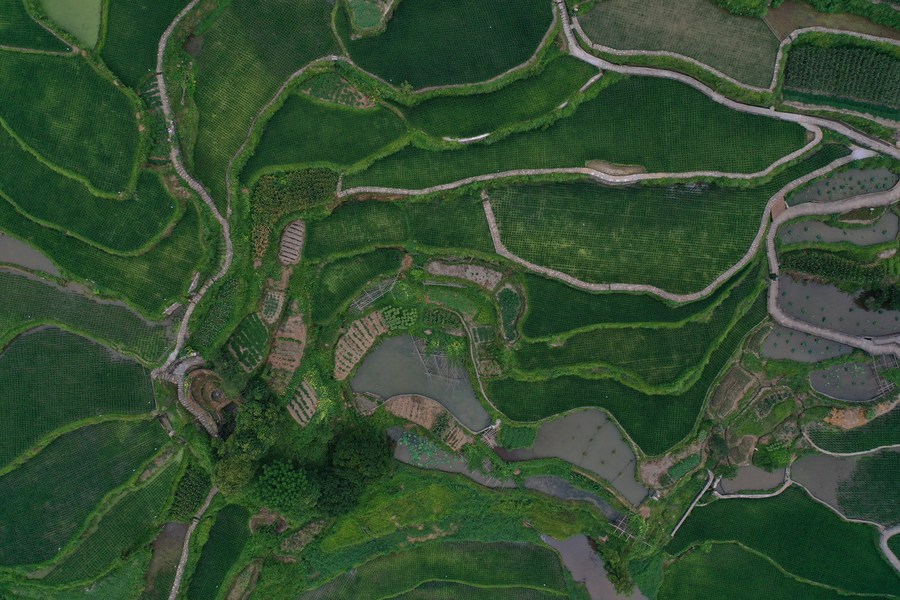
Staff show the making skills of Wuyi rock tea (Dahongpao) during a tea culture event held in Fuzhou, southeast China's Fujian Province, May 21, 2023. /Xinhua
Staff show the making skills of Wuyi rock tea (Dahongpao) during a tea culture event held in Fuzhou, southeast China's Fujian Province, May 21, 2023. /Xinhua
Editor's note: Wang Xiaofeng is a member of the CPC Leading Group of the Ministry of Culture and Tourism and president of the China Intangible Cultural Heritage Protection Association. The article reflects the author's opinions and not necessarily the views of CGTN.
Civilization, as a symbol of the constant evolution of human society, represents the cumulative wealth created by mankind in the process of transforming the world. It not only encompasses the relations among individuals and between people and society, but also defines the relations between nations through constant interaction and mutual learning.
Intangible cultural heritage, as the crystallization and shared spiritual wealth of human civilization, carries an irreplaceable cultural mission in the context of the Global Civilization Initiative.
Since the 1980s, The United Nations Educational, Scientific and Cultural Organization (UNESCO) has realized that with the societal changes brought about by economic globalization and changes in the human living environment, intangible cultural heritage has become more fragile and more vulnerable to natural or man-made damage than tangible cultural heritage. Thus, its protection has become an urgent task.
After deliberations and long-term research, UNESCO adopted the convention for the safeguarding of the intangible cultural heritage in 2003. China joined it the following year, becoming the sixth contracting party of the convention.
This year marks the 20th anniversary of the convention that has provided an effective platform for governments worldwide to strengthen exchanges among civilizations and promote cultural cooperation. The protection and inheritance of intangible cultural heritage have thus become a critical driving force for the mutual learning among global civilizations and for building a community with a shared future for mankind.
China's intangible cultural heritage is an important part of our exceptional traditional culture and serves as a testament to the continuity of Chinese civilization. As one of the earliest contracting parties of the convention, China is home to an abundant and diverse pool of intangible cultural heritage.
Up to now, China has 43 items on the UNESCO's list of intangible cultural heritage, ranking first in the world. Currently, China has established a tiered system of intangible cultural heritage, spanning the national, provincial, municipal and county levels. More than 100,000 items at all levels have been registered in the system, thereby affirming China's status as a leading nation of intangible cultural heritage.
Based on the national, provincial, city, and county (district) inheritance systems for intangible cultural heritage, we have established 23 national cultural ecological protection zones. China's intangible cultural heritage contributes a distinct Chinese element to the cultural diversity of the world and provides unique Chinese experience for the protection of intangible cultural heritage worldwide.

A protection area of the rice-fish co-culture system in Qingtian County, east China's Zhejiang Province, July 18, 2022. /Xinhua
A protection area of the rice-fish co-culture system in Qingtian County, east China's Zhejiang Province, July 18, 2022. /Xinhua
The land Silk Road initiated during the Western Han Dynasty and the maritime Silk Road that flourished during the Tang and Song dynasties were vital routes for cultural exchange and trade between ancient China and foreign countries. Through the two routes, the silk, ceramics and tea, which came in short supply, were exchanged for gold coins from Rome, glazes from the western regions and spices from the South China Sea.
Therefore, the Chinese intangible cultural heritage has always been a distinctive mark of the industrious and intelligent Chinese nation standing tall in the world civilization map, nurturing a diverse yet harmonious civilization, ultimately becoming an indispensable and vibrant symbol of the Chinese civilization.
The world order has experienced severe shocks after stepping into the second decade of this century, with globalization, multi-polarity and anti-globalization co-existing. How to build a peaceful and stable environment, promote economic development, and improve people's livelihood in such chaotic circumstances has become a common challenge for all countries.
In such extraordinary times, the practical significance of exchange and mutual learning among civilizations is even more highlighted. Civilization is colorful, equal and inclusive. Cultural diversity can mitigate disagreements, and intangible cultural heritage, stemming from life, help build harmony.
In April this year, Chinese President Xi Jinping and French President Emmanuel Macron had an informal meeting in Guangzhou, where they strolled in the garden, listened to the masterpiece played on Guqin, savored the traditional Chinese tea, and had a constructive discussion.
The amiable atmosphere of this conversation was underpinned by a series of major cooperation agreed upon by China and France during Macron's visit, as well as a 51-point joint statement. Both the Guqin art and tea-making skill, which played a part in this diplomatic success, have been listed in the UNESCO Intangible Cultural Heritage. The two millennia-old arts that are crystallizations of ancient Chinese wisdom, with their significant weight in modern diplomacy, have fully demonstrated the special value and advantages of intangible cultural heritage in international exchanges and cooperation.
Over the millennia, through the inheritance of intangible cultural heritage, the human pursuit of beautiful things and aspiration for a better life has never changed. This commonality allows us to foresee the bright future of exchange and mutual learning among civilizations and the building of an inclusive and open world.
At a time when the destinies of nations are intertwined, we must acknowledge the diversity of global culture, respect the culture of all nations, draw insights from different civilizations, and join hands to address the common challenges faced by mankind. Only then can we truly have a diverse and vibrant civilization for all mankind.
China Institute for Innovation and Development Strategy also contributed to this article.
(If you want to contribute and have specific expertise, please contact us at opinions@cgtn.com. Follow @thouse_opinions on Twitter to discover the latest commentaries in the CGTN Opinion Section.)